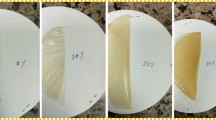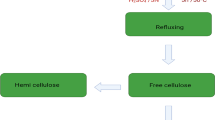Abstract
In this study, polyethylene oxide/bentonite/polyaniline (PEO/Bentonite/PANI) composite membrane with enhanced dye rejection and adsorption was constructed by phase inversion technique for the first time. The prepared membranes (PEO, PEO/Bentonite, and PEO/Bentonite/PANI) are characterized using XRD, FTIR, FESEM, and contact angle. These samples were tested as both filtration and adsorptive membranes. Comparative study for simultaneous removal for methyl orange (MO) and methylene blue (MB) in a mixed dye solution using PEO, PEO/Bentonite, and PEO/Bentonite/PANI membranes was investigated. The FESEM analysis showed that the surface of the composite membrane became uniform, free of agglomerates, and its pores became smaller after hybridization with bentonite and PANI proving the well compatibility between membrane constituents. Additionally, FTIR results demonstrated the good interaction between PEO, bentonite, and PANI in the composite membrane. The dye adsorption performance of the PEO/Bentonite/PANI membrane toward decolorization of MO and MB was studied under various conditions; the adsorbent dose ranged from 1.5 to 3 g/L, dye concentration (2.5, 5, 7.5, 10 mg/L), and pH (3, 5, 7, 9, 11). The results revealed that the composite can remove 94% of MO and 96% of MB. Finally, the rejection of MO and MB through the prepared composite membrane was 83% and 85%, respectively. These results suggest that PEO/Bentonite/PANI membrane can be applied as a pressure filtration and/or adsorption membrane for the removal of other pollutants from wastewater.









Similar content being viewed by others

References
Han H, Rafiq MK, Zhou T, Xu R, Masek O, Li X (2019) A critical review of clay based composites with enhanced adsorption performance for metal and organic pollutants. J Hazard Mater 369:780–796
Jain P, Sahoo K, Mahiya L, Ojha H, Trivedi H, Parmar AS, Kumar M (2021) Color removal from model dye effluent using PVA-GA hydrogel beads. J Environ Manage 281:111797
Gago D, Chagas R, Ferreira LM, Velizarov S, Coelhoso I (2020) A novel cellulose-based polymer for efficient removal of methylene blue. Membranes 10(1):13
Deng C, Liu J, Zhou W, Zhang YK, Du KF, Zhao ZM (2012) Fabrication of spherical cellulose/carbon tubes hybrid adsorbent anchored with welan gum polysaccharide and its potential in adsorbing methylene blue. Chem Eng J 200:452–458
Russo V, Masiello D, Trifuoggi M, Di Serio M, Tesser R (2016) Design of an adsorption column for methylene blue abatement over silica: from batch to continuous modeling. Chem Eng J 302:287–295
He X, Male KB, Nesterenko PN, Brabazon D, Paull B, Luong JH (2013) Adsorption and desorption of methylene blue on porous carbon monoliths and nanocrystalline cellulose. ACS Appl Mater Interfaces 5(17):8796–8804
Liu Y, Wang J, Zheng Y, Wang A (2012) Adsorption of methylene blue by kapok fiber treated by sodium chlorite optimized with response surface methodology. Chem Eng J 184:248–255
Liu Y, Song L, Du L, Gao P, Liang N, Wu S, Minami T, Zang L, Yu C, Xu X (2020) Preparation of polyaniline/emulsion microsphere composite for efficient adsorption of organic dyes. Polymers 12(1):167
Pathania D, Sharma S, Singh P (2017) Removal of methylene blue by adsorption onto activated carbon developed from Ficus carica bast. Arab J Chem 10:S1445–S1451
Avramescu ME, Borneman Z, Wessling M (2008) Particle-loaded hollow-fiber membrane adsorbers for lysozyme separation. J Membr Sci 322(2):306–313
Zhou B, Tang Y, Zhao L, Guo L, Zhou J (2021) Novel Fe3O4–poly (methacryloxyethyltrimethyl ammonium chloride) adsorbent for the ultrafast and efficient removal of anionic dyes. RSC Adv 11(2):1172–1181
Robinson T, McMullan G, Marchant R, Nigam P (2001) Remediation of dyes in textile effluent: a critical review on current treatment technologies with a proposed alternative. Bioresour Technol 77(3):247–255
Wang XS, Zhou Y, Jiang Y, Sun C (2008) The removal of basic dyes from aqueous solutions using agricultural by-products. J Hazard Mater 157(2–3):374–385
Giwa A, Ogunribido A (2012) The applications of membrane operations in the textile industry: a review. Curr Appl Sci Technol 2(3):296–310
Baheri B, Ghahremani R, Peydayesh M, Shahverdi M, Mohammadi T (2016) Dye removal using 4A-zeolite/polyvinyl alcohol mixed matrix membrane adsorbents: preparation, characterization, adsorption, kinetics, and thermodynamics. Res Chem Intermed 42(6):5309–5328
Ai L, Jiang J, Zhang R (2010) Uniform polyaniline microspheres: a novel adsorbent for dye removal from aqueous solution. Synth Met 160(7–8):762–767
Jamil S, Ahmad Z, Ali M, Khan SR, Ali S, Hammami MA, Haroon M, Saleh TA, Associate MRSAJ (2021) Synthesis and characterization of polyaniline/nickel oxide composites for fuel additive and dyes reduction. Chem Phys Lett 776:138713
Haitham K, Razak S, Nawi MA (2019) Kinetics and isotherm studies of methyl orange adsorption by a highly recyclable immobilized polyaniline on a glass plate. Arab J Chem 12(7):1595–1606
Ayad MM, El-Nasr AA (2010) Adsorption of cationic dye (methylene blue) from water using polyaniline nanotubes base. J Phys Chem C 114(34):14377–14383
Ali V, Kaur R, Kamal N, Singh S, Jain SC, Kang HPS, Zulfequar M, Husain M (2006) Use of Cu+1 dopant and it’s doping effects on polyaniline conducting system in water and tetrahydrofuran. J Phys Chem Solids 67(4):659–664
Ali V, Kaur R, Lakshmi GBVS, Kumar A, Kumari K, Kumar S (2012) Electrical conductivity and dielectric parameters of polyaniline doped with CuClO4·4BN in aqueous DMSO solvent. Adv Polym Technol 31(4):374–379
Ansari R, Mosayebzadeh Z (2011) Application of polyaniline as an efficient and novel adsorbent for azo dyes removal from textile wastewaters. Chem Pap 65(1):1–8
Baseri JR, Palanisamy PN, Sivakumar P (2012) Application of polyaniline nano composite for the adsorption of acid dye from aqueous solutions. E-J Chem 9(3):1266–1275
Salem MA (2010) The role of polyaniline salts in the removal of direct blue 78 from aqueous solution: a kinetic study. React Funct Polym 70(10):707–714
Rahimi R, Kerdari H, Rabbani M. (2010) Adsorptive removal of crystal violet (CV), a carcinogenic textile dye, from aqueous solution by conducting polyaniline/hollow manganese ferrite nanocomposites. In Proceedings of the ECSOC-14: the 14th international electronic conference on synthetic organic chemistry, Basel, Switzerland, pp. 1–30
Chowdhury AN, Jesmeen SR, Hossain MM (2004) Removal of dyes from water by conducting polymeric adsorbent. Polym Adv Technol 15(11):633–638
Singla ML, Jain DVS (2000) Adsorption of eriochrome black T on polyaniline from aqueous and methanolic solutions. Indian J Chem A (IJC-A) 39:603–610
Zhao Y, Chen H, Li J, Chen C (2015) Hierarchical MWCNTs/Fe3O4/PANI magnetic composite as adsorbent for methyl orange removal. J Colloid Interface Sci 450:189–195
Gao Y, Chen C, Tan X, Xu H, Zhu K (2016) Polyaniline-modified 3D-flower-like molybdenum disulfide composite for efficient adsorption/photocatalytic reduction of Cr (VI). J Colloid Interface Sci 476:62–70
Kaur R, Duhan M (2017) Polyaniline as an inceptive dye adsorbent from effluent. chapter 3. In: Advanced materials for wastewater treatment. Wiley: Martin Scrivener, Sweden. pp. 51–100
Wang P, Wang X, Chen X, Ren L (2021) Effects of bentonite on antibiotic resistance genes in biogas slurry and residue from thermophilic and mesophilic anaerobic digestion of food waste. Bioresour Technol 336:125322
Ren S, Meng Z, Sun X, Lu H, Zhang M, Lahori AH, Bu S (2020) Comparison of Cd2+ adsorption onto amphoteric, amphoteric-cationic and amphoteric-anionic modified magnetic bentonites. Chemosphere 239:124840
Aichour A, Zaghouane-Boudiaf H (2020) Synthesis and characterization of hybrid activated bentonite/alginate composite to improve its effective elimination of dyes stuff from wastewater. Appl Water Sci 10(6):1–13
Ali A (2020) Ternary system from mesoporous CdS–ZnS modified with polyaniline for removal of cationic and anionic dyes. Res Chem Intermed 46:571
Zhang H, Shi Y, Xu X, Zhang M, Ma L (2020) Structure regulation of bentonite-alginate nanocomposites for controlled release of imidacloprid. ACS Omega 5(17):10068–10076
Zhang M, Wang X, Yang T, Zhang P, Wei X, Zhang L, Li H (2020) Polyaniline/graphene hybrid fibers as electrodes for flexible supercapacitors. Synth Met 268:116484
Rajakani P, Vedhi C (2015) Electrocatalytic properties of polyaniline–TiO2 nanocomposites. Int J Ind Chem 6(4):247–259
Zhou Z, Zhang X, Lu C, Lan L, Yuan G (2014) Polyaniline-decorated cellulose aerogel nanocomposite with strong interfacial adhesion and enhanced photocatalytic activity. RSC Adv 4(18):8966–8972
Bahrudin NN, Nawi MA, Ismail WINW (2018) Physical and adsorptive characterizations of immobilized polyaniline for the removal of methyl orange dye. Korean J Chem Eng 35(7):1450–1461
Govindasamy K, Dahlan NA, Janarthanan P, Goh KL, Chai SP, Pasbakhsh P (2020) Electrospun chitosan/polyethylene-oxide (PEO)/halloysites (HAL) membranes for bone regeneration applications. Appl Clay Sci 190:105601
Pathalamuthu P, Siddharthan A, Giridev VR, Victoria V, Thangam R, Sivasubramanian S, Savariar V, Hemamalini TJIJOBM (2019) Enhanced performance of Aloe vera incorporated chitosan-polyethylene oxide electrospun wound scaffold produced using novel Spirograph based collector assembly. Int J Biol Macromol 140:808–824
Ozola-Davidane R, Burlakovs J, Tamm T, Zeltkalne S, Krauklis AE, Klavins M (2021) Mentonite-ionic liquid composites for congo red removal from aqueous solutions. J Mol Liq 37:1163733
Pramono E, Alfiansyah R, Ahdiat M, Wahyuningrum D, Radiman CL (2019) Hydrophilic poly (vinylidene fluoride)/bentonite hybrid membranes for microfiltration of dyes. Mater Res Expr 6(10):105376
He P, Zhao S, Mao C, Wang Y, Ma G, Wang Z, Wang J (2021) In-situ growth of double-layered polyaniline composite membrane for organic solvent nanofiltration. Chem Eng J 420:129338
Yang P, Xu Y, Tuo J, Li A, Liu L, Shi H (2019) Preparation of modified pomelo peel’s pulp adsorbent and its adsorption to uranyl ions. R Soc Open Sci 6(3):181986
Kubra KT, Salman MS, Hasan MN (2021) Enhanced toxic dye removal from wastewater using biodegradable polymeric natural adsorbent. J Mol Liq 328:115468
Saleh TA, Gupta VK (2012) Photo-catalyzed degradation of hazardous dye methyl orange by use of a composite catalyst consisting of multi-walled carbon nanotubes and titanium dioxide. J Colloid Interface Sci 371(1):101–106
Shabaan OA, Jahin HS, Mohamed GG (2020) Removal of anionic and cationic dyes from wastewater by adsorption using multiwall carbon nanotubes. Arab J Chem 13(3):4797–4810
Moghazy RM, Labena A, Husien S, Mansor ES, Abdelhamid AE (2020) Neoteric approach for efficient eco-friendly dye removal and recovery using algal-polymer biosorbent sheets: characterization, factorial design, equilibrium and kinetics. Int J Biol Macromol 157:494–509
Duhan M, Kaur R (2020) Adsorptive removal of methyl orange with polyaniline nanofibers: an unconventional adsorbent for water treatment. Environ Technol 41(23):2977–2990
Janaki V, Oh BT, Shanthi K, Lee KJ, Ramasamy AK, Kamala-Kannan S (2012) Polyaniline/chitosan composite: an eco-friendly polymer for enhanced removal of dyes from aqueous solution. Synth Met 162(11–12):974–980
Şahin Ö, Kaya M, Saka C (2015) Plasma-surface modification on bentonite clay to improve the performance of adsorption of methylene blue. Appl Clay Sci 116:46–53
Hao S, Zhang T, Fan S, Jia Z, Yang Y (2021) Preparation of COF-TpPa1 membranes by chemical vapor deposition method for separation of dyes. Chem Eng J 421:129750
Acknowledgements
Dr. Ali would like to thank Prof. Zahra Saleh, Central Laboratories Network and The Centers of Excellence, NRC, for the availability of the laboratory and equipments.
Author information
Authors and Affiliations
Corresponding author
Ethics declarations
Conflict of interest
The authors declare that they have no competing interests.
Additional information
Publisher's Note
Springer Nature remains neutral with regard to jurisdictional claims in published maps and institutional affiliations.
Rights and permissions
About this article
Cite this article
Ali, H., Mansor, E.S. & Taha, G.M. Microfiltration and adsorptive membranes for simultaneous removal of methyl orange and methylene blue using hybrid composites. Polym. Bull. 79, 7891–7908 (2022). https://doi.org/10.1007/s00289-021-03884-7
Received:
Revised:
Accepted:
Published:
Issue Date:
DOI: https://doi.org/10.1007/s00289-021-03884-7



